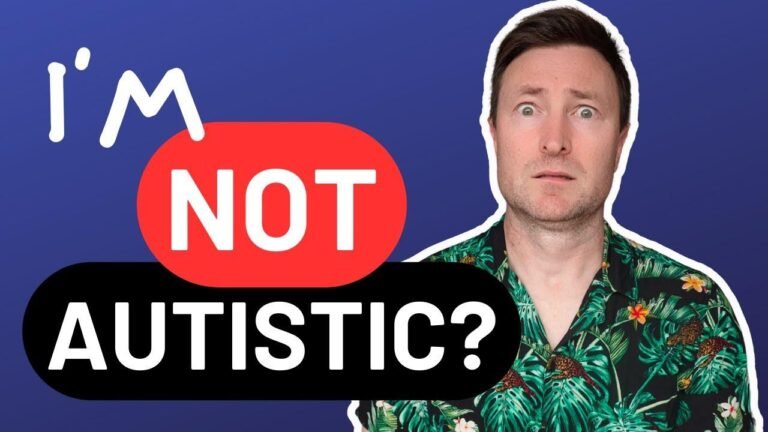Autistisches Stimming: Einblicke und Erfahrungen - Teil 14 #AutismAwareness
Navigating the secret river of ‘invisible stemming’ is like a late-diagnosed autistic adult discovering they’ve been whitewater rafting blindfolded all their lives! 🚣♂️👀 #UnlockTheFlow #AutismAwareness
Understanding the Experience of Late-Diagnosed Autistic Adults: Key Insights 📘
| Das Wichtigste zum Mitnehmen | Detail |
|---|---|
| Covert Stimming | Late-diagnosed adults often employ subtle, unnoticeable stimming behaviors. |
| Unrecognized Stimming Behaviors | Many resort to harmful or self-soothing activities without realizing they serve as stimming. |
| Challenge of Unmanaged Energy | Unchanneled autistic energy can lead to negative outcomes like self-harm. |
| Increasing Awareness | Recognizing and accepting stimming is crucial for well-being. |
| Support Systems | Engaging in support groups can aid in managing the challenges faced by autistic adults. |
Exploring the Hidden World of Covert Stimming in Autistic Adults 🕵️♂️
Why Covert Stimming is More Prevalent in Adults Diagnosed Late
Covert stimming involves subtle actions like toe scrunching, hair twirling, or blinking repeatedly, which are often overlooked but crucial for emotional regulation. These behaviors can be vital for managing pent-up energy.
Understanding the Role of Unchanneled Energy
Due to heightened sensitivity and vigilance, autistic individuals perceive and absorb vast amounts of sensory data, leading to excessive internal energy. Managing this without proper guidance or awareness can result in maladaptive coping mechanisms like self-harm or substance use.
Communication Through Stimming: An Overlooked Aspect
For many autistic individuals, stimming is not just a method for emotional regulation; it’s also a form of non-verbal communication, expressing joy or satisfaction, which is often misunderstood in social contexts.
The Link Between Late Diagnosis and Stimming Challenges 🧩
How Delayed Autism Diagnosis Affects Understanding of Self-stimming
Being diagnosed late often means missing out on early interventions or education about how to effectively manage and embrace stimming behaviors, resulting in years of misunderstanding one’s own needs and behaviors.
The Psychological Impact of Late Diagnosis
Not understanding or having support for autistic traits can lead to increased anxiety and stress, compounding the challenges of managing stimming behaviors.
Redirecting Negative Stimming into Positive Outcomes
Recognition of stimming’s role and purpose can help in redirecting potentially harmful behaviors towards more positive and harmless forms of stimming, such as engaging with sensory toys or attending therapy.
Interventions and Support Systems for Managing Stimming 🆘
Role of Support Groups in Helping Autistic Adults
Support groups provide a platform for sharing experiences, strategies, and support, which is vital for late-diagnosed adults who might have spent years feeling isolated or misunderstood.
Importance of Professional Guidance and Counseling
Counseling can equip autistic adults with strategies to recognize and modify stimming behaviors, ensuring they serve a constructive rather than destructive role.
Developing Personal Coping Mechanisms
Encouraging the development of personalized coping mechanisms can ensure that stimming acts as a tool for well-being rather than a source of distress.
Advocating for Better Awareness and Acceptance of Stimming 🎗️
The Need for Societal Acceptance
Promoting awareness and acceptance of stimming behaviors can reduce stigma and increase autonomy among autistic individuals, making social environments more inclusive.
Mobilizing Community and Online Resources
Utilizing online platforms and community resources to educate and support not just autistic individuals but also society at large can create conducive environments where stimming is recognized and accepted.
Legal and Educational Reforms
Advocating for changes in policies to accommodate and support autistic behaviors in education systems and workplaces can significantly improve quality of life and social integration.
Conclusion: Empowering Autistic Individuals through Understanding and Acceptance 🚀
Discovering and embracing one’s stimming behaviors can immensely benefit autistic adults, especially those diagnosed late in life. Social acceptance and supportive networks are instrumental in turning stimming from a covert necessity into an embraced aspect of life. Engaging with communities and educating the broader public can foster environments that nourish rather than suppress autistic identities.







